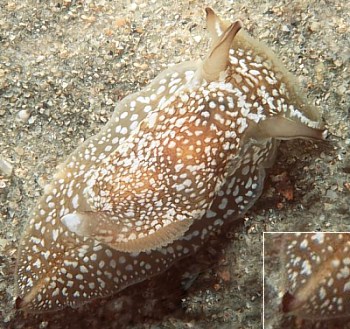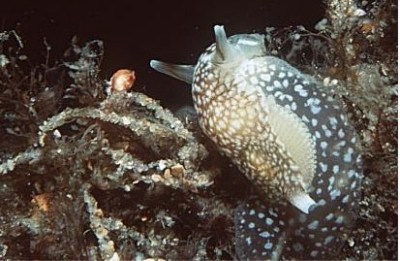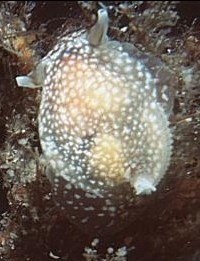Pleurobranchaea inconspicua? from Florida
August 22, 2001
From: Anne DuPont

Hi Bill,
I know you have a backlog of notes, and I hate to burden you with another note, but just had to share this side-gill slug with you. Sandra Millen has identified it for me as Pleurobranchaea inconspicua Bergh, 1897
West Palm Beach, Florida, USA, Depth: 15 feet. February, 2001. Photo: Anne DuPont
Size: UPPER: Animal aprox. 2 inches long.
[Inset showing spur on posterior tip of foot]. LOWER: The two with eggs were about 1 inch long.
I include these comments from Sandra Millen:
"The side gill slug is Pleurobranchaea inconspicua Bergh, 1897. Its synonoms are P. hedgpethi & P. gela. It is a Pleurobranchaea because its rhinophores are far apart (not together at the base) and it is interesting because the veil has tiny frimbulations, the mantle has a siphon at the back and the tail has a posterior spur, all of which can be seen in your photo."
[Sandra Millen,
Department of Zoology,
University of British Columbia,
Vancouver, B.C., Canada, V6T 1Z4
millen@zoology.ubc.ca]
Best wishes,
Anne DuPont.
adupont@gate.net


Dear Anne,
Don't ever hesitate to send messages. Although I have a growing backlog I always have time for new and interesting material. As I think I mentioned with your recent message about the Hypselodoris from Florida, every time I try and research a species from the Caribbean I discover an almost total lack of information. This Pleurobranchaea is a case in point. I can find no description of a west Atlantic species with this very distinctive colour pattern of large opaque white spots. In fact there is no good colour description of any west Atlantic species of Pleurobranchaea, most being described from preserved material. Abbott (1952) noted in his description of P. hedgepthi, which is considered a synonym of P. inconspicua, that:
"Mr Hedgepeth recalls that in life they were sepia brown with lighter mottlings".
I don't know if the white spots on the animal you have photographed could be sensibly described as having 'lighter mottling' but it does illustrate the difficulty in identifying these species.
Marcus & Gosliner (1982) list the following species which have been recorded from the Florida region.
• P. tarda Verrill [= occidentalis] - sometimes has a short spur on tail but often without spur; live animal has brown and translucent clear mottlings; oral veil with many papillae
• P. agassizi Bergh, 1897 - nothing known of living colour; has spur on tail
• P. inconspicua Bergh, 1897 [= P. hamwa, P. hedgepethi, P. gela] - spur on tail; no unambiguous colour information
• P. bonnieae Marcu & Gosliner, 1984 - Described as new from one preserved animal, perhaps juvenile specimen - no information on living colour or shape.
Not a lot to go on. It seems from Marcus & Gosliner's revision that there are reasonable anatomical differences between species. Perhaps Sandra has looked at the anatomy of your white-spotted animals. If not, it would seem a very useful thing to do, because if we knew the anatomy of the animal with this characteristic colour pattern, it should be possible to match it with one of the species reviewed in Marcus & Gosliner.
References:
• Abbott, R.T. (1952): Two new opisthobranch mollusks from the Gulf of Mexico belonging to the genera Pleurobranchaea and Polycera. Florida State University Studies, 7: 1-7.
• Marcus, Er. & Marcus, Ev. (1967) American opisthobranch mollusks. Part 1, Tropical American opisthobranchs. Studies in Tropical Oceanography, Miami, 6(1-2): 1-137. (Figs 1-150, Pl.1, figs 1-9).
• Marcus, E. & Gosliner, T.M. (1984) Review of the family Pleurobranchaeidae (Mollusca, Opisthobranchia). Annals of the South African Museum, 93(1): 1-52.
By the way I can't see the egg masses you mention. Are they the curved string-like objects in the lower left photo?
Best wishes,
Bill Rudman
Related messages
-
Pleurobranchaea inconspicua from Cozumel, Mexico
From: Jim Lyle, March 4, 2005 -
Pleurobranchaea hedgpethi from Belize
From: Dave Behrens, October 14, 2002 -
Re: Pleurobranchaea cf. inconspicua
From: Sandra Millen, August 28, 2001
